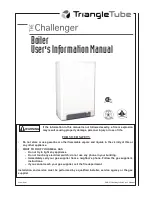
User manual HRE-serie version 6, November 2013
8
4.1.2 Connection to the central heating system
PIPING
Take note of the following points, when installing the piping:
Install the piping in such a way, that the boiler (cover and dashboard) remains accessible;
Provide enough bleeding points in places where air may collect, especially near the boiler.
Attention:
Install a bleeding point near the
boiler, especially when the piping
does not go up.
Connect the piping to the boiler as follows (see figure 2):
1. Install the feed from the CH at point 1;
2. Install the return of the CH at point 2
Hint:
Install a shunt with pressure equalizer, when thermostatic radiator valves are
applied.
4.1.3 Flue gas outlet
GENERAL
The flue gas outlet is an essential part of your heating installation. An incorrect flue gas outlet reduces
the lifespan of your boiler considerably and has a negative impact on the efficiency. Remember when
installing the flue, that even the best boiler won't work properly unless the flue is properly installed.
Warning:
Because the flue gas temperature lies between 180-240°C, it is advisable to
insulate the flue with heat-resistant material on those parts where contact
with human body parts is possible.
For a correct flue gas outlet the following points need to be observed:
Use the proper diameter, use a diameter equal to the diameter of the flue gas outlet on the boiler
(see also technical specification).
Use double-walled chimney pipe outside to prevent a rapid cooling of the dlue gasses, which may
result in condensation in the chimney.
Hint:
When using an existing chimney of a larger diameter than the diameter on
the boiler, you can
install flexible piping of the correct diameter insides
the existing chimney.
Warning
It is necessary that condense water always can flow back to the drain
or the boiler, avoid water bags!!
Figure 2









































